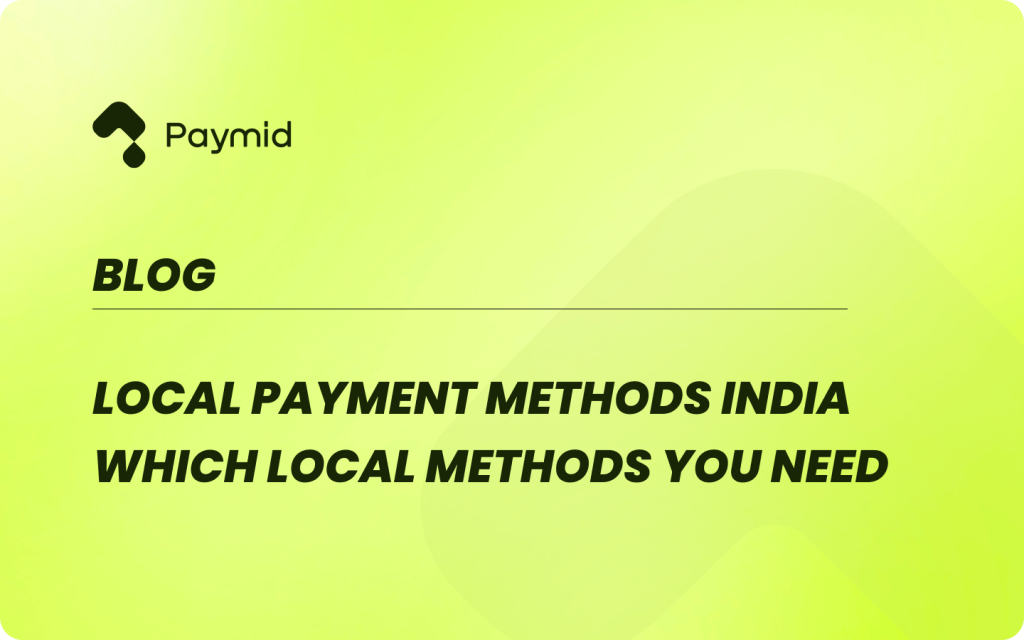Top Local Payment Methods in India: What Merchants Need to Know to Accept Indian Payments

India’s e-commerce market is booming, driven by a growing population, increasing smartphone penetration, and a shift toward digital transactions. As of March 28, 2025, the country’s digital payment ecosystem is one of the most dynamic in the world, offering a variety of local payment methods that cater to its diverse consumer base. For merchants looking to tap into this lucrative market, understanding and integrating the right payment options is crucial to reducing cart abandonment, building customer trust, and boosting sales. In this blog post, we’ll explore the top local payment methods in India and highlight the ones merchants absolutely need to accept Indian payments effectively.
The Rise of Digital Payments in India
India has seen a remarkable transformation in its payment landscape over the past decade. Initiatives like the government’s Digital India campaign, the introduction of the Unified Payments Interface (UPI), and the push for a cashless economy have accelerated the adoption of digital payments. With over 1.5 billion people and internet penetration nearing 50%, the potential for online commerce is immense. However, consumer preferences in India differ significantly from those in Western markets, making it essential for merchants to offer payment methods that resonate locally.
Top Local Payment Methods in India
Here’s a rundown of the most popular payment methods Indian consumers rely on for both domestic and cross-border shopping:
- Unified Payments Interface (UPI)
UPI, launched by the National Payments Corporation of India (NPCI), has revolutionized digital payments in India. It allows instant, real-time bank-to-bank transfers using a mobile device, integrating seamlessly with apps like Google Pay, PhonePe, and Paytm. UPI is fast, secure, and nearly free, making it the go-to choice for millions of Indians. Its interoperability across over 140 banks and e-wallets has fueled its dominance, with transaction volumes soaring year after year. For merchants, UPI is a must-have due to its widespread adoption and ease of use. - Paytm
Paytm is India’s leading digital wallet and payment platform, boasting over 300 million users. It enables consumers to shop online, pay bills, book tickets, and more, all from a single app. According to studies, Paytm ranks as the favorite payment method for a significant portion of online shoppers in India. Its versatility and trust factor make it a critical option for merchants targeting Indian customers. - Google Pay and PhonePe
Built on top of UPI, Google Pay and PhonePe are hugely popular mobile payment apps. Google Pay, with its intuitive interface and local partnerships, is favored by a large segment of online shoppers, while PhonePe offers a similar one-stop solution for payments and transfers. Both are essential for merchants aiming to capture the mobile-first Indian market. - Credit and Debit Cards (Visa, Mastercard, RuPay)
While card penetration remains relatively low compared to digital wallets and UPI, cards still account for a significant share of e-commerce transactions by value. Visa and Mastercard are widely accepted, but RuPay, India’s homegrown card scheme, is gaining traction due to its affordability and government backing. However, many Indian cards aren’t enabled for international purchases, so cross-border merchants may need a local payment processor to accept them effectively. - Netbanking and Bank Transfers
India has a mature online banking system, including options like Netbanking (direct bank authentication for purchases), IMPS (instant transfers), and traditional methods like NEFT and RTGS. These are particularly popular for high-value transactions and among consumers with bank accounts but no cards. As bank account penetration grows, these methods remain relevant. - Cash on Delivery (COD)
Despite the digital payment surge, cash on delivery remains a vital option, especially in smaller cities and rural areas where trust in online payments is still developing. COD allows customers to pay in cash when their order arrives, reducing hesitation for first-time online buyers. While it’s declining in urban centers, it’s still a key method for broader reach. - Other Digital Wallets (Amazon Pay, Airtel Money, MobiKwik)
Beyond Paytm, wallets like Amazon Pay, Airtel Money, and MobiKwik cater to niche audiences. Amazon Pay leverages its e-commerce ecosystem, while Airtel Money ties into telecom services. These wallets offer convenience and are often linked to UPI, making them supplementary but valuable options.
Which Payment Methods Do Merchants Need?
To successfully accept payments from Indian customers, merchants must prioritize methods that align with local preferences and maximize conversion rates. Here’s what you need:
- UPI (Mandatory)
UPI is non-negotiable. Its dominance in the Indian payment landscape—thanks to its speed, low cost, and integration with popular apps—makes it the backbone of digital transactions. Whether you’re a domestic or cross-border merchant, offering UPI through platforms like Google Pay, PhonePe, or Paytm is essential to meet customer expectations. - Paytm (Highly Recommended)
As the most popular digital wallet, Paytm is a must for merchants targeting a broad Indian audience. Its massive user base and versatility make it a trusted choice for consumers, especially for small to medium transactions. - Credit/Debit Cards with Local Processing (Essential for High-Value Sales)
While not as ubiquitous as UPI, cards are critical for capturing the top end of the market, particularly for higher-value purchases. Merchants should support Visa, Mastercard, and RuPay, but cross-border sellers need a local partner to process these payments, as many Indian cards are restricted to domestic use. - Cash on Delivery (Strategic for Reach)
For merchants aiming to penetrate tier-2 and tier-3 cities or rural markets, COD is a strategic necessity. It builds trust among hesitant buyers, though it comes with logistical challenges and higher return rates. - Netbanking (Optional but Useful)
Offering Netbanking or bank transfer options like IMPS can cater to customers without cards or digital wallets, especially for larger transactions. It’s not a primary method but adds flexibility.
Why These Methods Matter
Indian consumers value convenience, trust, and familiarity in their payment options. UPI and Paytm dominate because they’re fast, secure, and widely accepted, while cards and COD address specific segments of the market. By integrating these methods, merchants can:
- Reduce Cart Abandonment: Offering preferred payment options ensures customers complete their purchases.
- Build Loyalty: Familiar methods create a seamless experience, encouraging repeat business.
- Expand Reach: Supporting COD and bank transfers opens doors to less digitally savvy regions.
Tips for Merchants
- Partner with a Local Payment Gateway: Platforms like Paymid offer robust support for UPI, wallets, cards, and more, simplifying integration.
- Optimize for Mobile: With most transactions happening on smartphones, ensure your checkout process is mobile-friendly.
- Stay Compliant: Adhere to Reserve Bank of India (RBI) regulations, especially for cross-border payments, to avoid legal hurdles.
Conclusion
India’s payment ecosystem is a blend of innovation and tradition, with UPI leading the charge and legacy methods like COD holding strong. For merchants, prioritizing UPI, Paytm, and card payments—supplemented by COD and Netbanking—unlocks the full potential of this vibrant market. By aligning with these local preferences, you can position your business to thrive in India’s $36.5 billion (and growing) e-commerce landscape. Ready to capture your slice of the Indian market? Start integrating these payment methods today!

